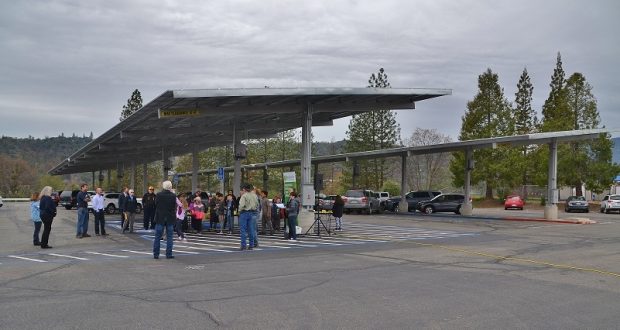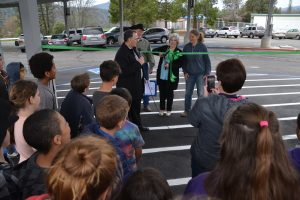
Superintendent Darrin Sylvia, and Chawanakee Unified Board Members Jessie Hutchens, Barbara Bigelow and Claudia Box cut ribbon on Solar Project – photo by Gina Clugston
NORTH FORK – A bit of overcast didn’t stop students at North Fork Elementary School from learning about, and being amazed by the power of the sun.
On Friday, Mar. 24, students and teachers, administrators and Chawanakee School Board members gathered for the ribbon cutting ceremony for the new solar arrays now providing power at the North Fork School.
The project was made possible by funding from Proposition 39, passed in 2012 by California voters, and paving the way for clean energy and energy conservation projects at schools across the state.
Dr. Rick Brown, president of TerraVerde Renewable Partners who coordinated the project, says every school district has an allocation from the State from Prop 39, and districts apply for eligible projects, which includes solar.
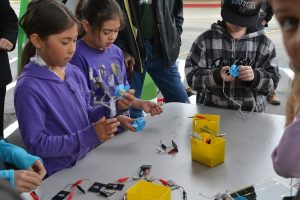 “Prop 39 closed an out-of-state corporate tax loophole, and by closing that loophole, the general fund is getting about $800 million a year,” said Brown. “Half of that money is devoted to clean energy project and energy conservation projects, and every school district in the state gets a piece of that money.”
“Prop 39 closed an out-of-state corporate tax loophole, and by closing that loophole, the general fund is getting about $800 million a year,” said Brown. “Half of that money is devoted to clean energy project and energy conservation projects, and every school district in the state gets a piece of that money.”
Under a Power Purchase Agreement, Chawanakee Unified School District has locked in a price of 16 cents per kilowatt-hour for the next 20 years, with the option to renew for another 5 years. According to District Superintendent Darren Sylvia, that will save the district several cents per kWh, and tens of thousands of dollars per year on energy costs, increasing those savings as power rates rise.
“Those funds come directly back in for our students, into the classrooms for supplies, teachers, field trips and enrichment activities,” said Sylvia.
Dr. Brown estimates that the solar arrays – one at North Fork Elementary and a larger array at Minarets High School – will save the District $45,000 to $50,000 a year on the 1.2 million kilowatt-hours they consume.
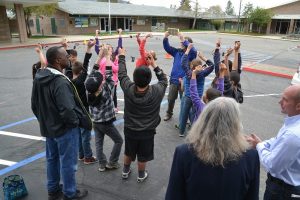 “It also creates an environmental benefit, eliminating emissions of various kinds of air pollutants,” said Dr. Brown. “Also, traditional power production uses a lot of water. Cleaner air and less use of water are two of the benefits.”
“It also creates an environmental benefit, eliminating emissions of various kinds of air pollutants,” said Dr. Brown. “Also, traditional power production uses a lot of water. Cleaner air and less use of water are two of the benefits.”
During the winter months, the school will use all the power produced by the arrays, but in the summer, when classrooms are closed and there is minimal use, the power will be exported to the grid, sold back to PG&E and credited to the District’s account.
The $2.5 million project is owned by the company that built it – Solar City – who manages and maintains the system, at no cost to the District. The benefit to Solar City is the tax credit from the federal government. Chawanakee has the option to purchase the arrays after five years when the tax credits are exhausted, at a price pre-determined by a values chart developed during contract negotiations. Or they can continue with the current arrangement for the 20 years of the contract, with an option to extend to 25 years.
Because of the quick action by the administration and the Board, said Dr. Brown, the District got their project approved ahead of a change in energy policies. That timely approval will increase the benefits by about 20 percent due to the project being grandfathered in to a lower rate structure.
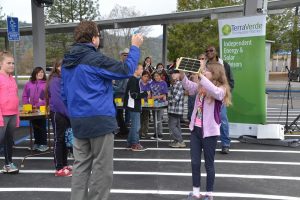 On the day of the ribbon cutting in North Fork, students in Mrs. Cottington’s 4th and 5th grade students were introduced to the wonders of solar power. Each was given a small solar panel to hold up toward the sky, and even through the overcast, the power of the sun was strong enough to energize the little fans attached to the panels.
On the day of the ribbon cutting in North Fork, students in Mrs. Cottington’s 4th and 5th grade students were introduced to the wonders of solar power. Each was given a small solar panel to hold up toward the sky, and even through the overcast, the power of the sun was strong enough to energize the little fans attached to the panels.
“This beautiful structure will help support energy on our campus, producing energy through the rays of the sun, and giving back to environment,” said Assemblyman Frank Bigelow, who presented Chawanakee School Board members Claudia Box, Barbara Bigelow and Jessie Hutchins with a Certificate of Recognition from the State Legislature for their years of dedication in bringing this project to fruition.
One added benefit of the arrays that will likely be appreciated by staff and visitors alike, is the shade they provide to the parking area at the school.

